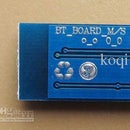Introduction: Arduino Serial
Serial communication on pins TX/RX uses TTL logic levels (5V or 3.3V
depending on the board). Don't connect these pins directly to an RS232 serial port; they operate at +/- 12V and can damage your Arduino board.
Serial is used for communication between the Arduino board and a computer or other devices. All Arduino boards have at least one serial port (also known as a UART or USART): Serial. It communicates on digital pins 0 (RX) and 1 (TX) as well as with the computer via USB. Thus, if you use these functions, you cannot also use pins 0 and 1 for digital input or output.
You can use the Arduino environment's built-in serial monitor to communicate with an Arduino board. Click the serial monitor button in the toolbar and select the same baud rate used in the call to begin().
The Arduino Mega has three additional serial ports: Serial1 on pins 19 (RX) and 18 (TX), Serial2 on pins 17 (RX) and 16 (TX), Serial3 on pins 15 (RX) and 14 (TX). To use these pins to communicate with your personal computer, you will need an additional USB-to-serial adaptor, as they are not connected to the Mega's USB-to-serial adaptor. To use them to communicate with an external TTL serial device, connect the TX pin to your device's RX pin, the RX to your device's TX pin, and the ground of your Mega to your device's ground.
Step 1: Command : If (Serial)
Description
Indicates if the specified Serial port is ready.
On 32u4 based boards (Leonardo, Yùn, ecc) , if (Serial) indicates whether or not the USB CDC serial connection is open. For all other instances, including if (Serial1) on the Leonardo, this will always return true.
This was introduced in Arduino 1.0.1.
Syntax
All boards: if (Serial)
Arduino Leonardo specific: if (Serial1)
Arduino Mega specific: if (Serial1) if (Serial2) if (Serial3)
Parameters
none
Returns
boolean : Returns true if the specified serial port is available. This will only return false if querying the Leonardo's USB CDC serial connection before it is ready.
Example:
void setup() {
//Initialize serial and wait for port to open:
Serial.begin(9600);
while (!Serial) {
; // wait for serial port to connect. Needed for native USB
}
}
void loop() {
//proceed normally
}
Step 2: Command : Available()
Description
Get the number of bytes (characters) available for reading from the serial port. This is data that's already arrived and stored in the serial receive buffer (which holds 64 bytes). available() inherits from the Stream utility class.
Syntax
Serial.available()
Arduino Mega only: Serial1.available() Serial2.available() Serial3.available()
Parameters
none
Returns
the number of bytes available to read
Example
int incomingByte = 0; // for incoming serial data
void setup() {
Serial.begin(9600); // opens serial port, sets data rate to 9600 bps
}
void loop() {
// send data only when you receive data:
if (Serial.available() > 0) {
// read the incoming byte:
incomingByte = Serial.read();
// say what you got:
Serial.print("I received: ");
Serial.println(incomingByte, DEC);
}
}
Step 3: Command : AvailableForWrite()
Description
Get the number of bytes (characters) available for writing in the serial buffer without blocking the write operation.
Syntax
Serial.availableForWrite()
Arduino Mega only:
Serial1.availableForWrite()
Serial2.availableForWrite()
Serial3.availableForWrite()
Step 4: Command : Begin()
Description
Sets the data rate in bits per second (baud) for serial data transmission. For communicating with the computer, use one of these rates: 300, 600, 1200, 2400, 4800, 9600, 14400, 19200, 28800, 38400, 57600, or 115200. You can, however, specify other rates - for example, to communicate over pins 0 and 1 with a component that requires a particular baud rate.
An optional second argument configures the data, parity, and stop bits. The default is 8 data bits, no parity, one stop bit.
Syntax
Serial.begin(speed) Serial.begin(speed, config)
Arduino Mega only: Serial1.begin(speed) Serial2.begin(speed) Serial3.begin(speed) Serial1.begin(speed, config) Serial2.begin(speed, config) Serial3.begin(speed, config)
Parameters
speed: in bits per second (baud) - long config: sets data, parity, and stop bits. Valid values are :
SERIAL_5N1
SERIAL_6N1
SERIAL_7N1
SERIAL_8N1 (the default)
SERIAL_5N2
SERIAL_6N2
SERIAL_7N2
SERIAL_8N2
SERIAL_5E1
SERIAL_6E1
SERIAL_7E1
SERIAL_8E1
SERIAL_5E2
SERIAL_6E2
SERIAL_7E2
SERIAL_8E2
SERIAL_5O1
SERIAL_6O1
SERIAL_7O1
SERIAL_8O1
SERIAL_5O2
SERIAL_6O2
SERIAL_7O2
SERIAL_8O2
Example:
void setup() {
Serial.begin(9600); // opens serial port, sets data rate to 9600 bps
}
void loop() {}
Step 5: Command : Serial.find()
Description
Serial.find() reads data from the serial buffer until the target string of given length is found. The function returns true if target string is found, false if it times out.
Serial.find() inherits from the Stream utility class.
Syntax
Serial.find(target)
Step 6: Command : Peek()
Description
Returns the next byte (character) of incoming serial data without removing it from the internal serial buffer. That is, successive calls to peek() will return the same character, as will the next call to read(). peek() inherits from the Stream utility class.
Syntax
Serial.peek()
Arduino Mega only:
Serial1.peek()
Serial2.peek()
Serial3.peek()
Step 7: Command : Print()
Description
Prints data to the serial port as human-readable ASCII text. This command can take many forms. Numbers are printed using an ASCII character for each digit. Floats are similarly printed as ASCII digits, defaulting to two decimal places. Bytes are sent as a single character. Characters and strings are sent as is. For example:
Serial.print(78) gives "78" Serial.print(1.23456) gives "1.23" Serial.print('N') gives "N" Serial.print("Hello world.") gives "Hello world." An optional second parameter specifies the base (format) to use; permitted values are BIN (binary, or base 2), OCT (octal, or base 8), DEC (decimal, or base 10), HEX (hexadecimal, or base 16). For floating point numbers, this parameter specifies the number of decimal places to use. For example:
Serial.print(78, BIN) gives "1001110" Serial.print(78, OCT) gives "116" Serial.print(78, DEC) gives "78" Serial.print(78, HEX) gives "4E" Serial.println(1.23456, 0) gives "1" Serial.println(1.23456, 2) gives "1.23" Serial.println(1.23456, 4) gives "1.2346" You can pass flash-memory based strings to Serial.print() by wrapping them with F(). For example :
Serial.print(F(“Hello World”)) To send a single byte, use Serial.write().
Syntax
Serial.print(val) Serial.print(val, format)
Parameters
val: the value to print - any data type
format: specifies the number base (for integral data types) or number of decimal places (for floating point types)
Returns
size_t (long): print() returns the number of bytes written, though reading that number is optional
Example:
/*
Uses a FOR loop for data and prints a number in various formats.
*/
int x = 0; // variable
void setup() {
Serial.begin(9600); // open the serial port at 9600 bps:
}
void loop() {
// print labels
Serial.print("NO FORMAT"); // prints a label
Serial.print("\t"); // prints a tab
Serial.print("DEC");
Serial.print("\t");
Serial.print("HEX");
Serial.print("\t");
Serial.print("OCT");
Serial.print("\t");
Serial.print("BIN");
Serial.print("\t");
for(x=0; x< 64; x++){ // only part of the ASCII chart, change to suit
// print it out in many formats:
Serial.print(x); // print as an ASCII-encoded decimal - same as "DEC"
Serial.print("\t"); // prints a tab
Serial.print(x, DEC); // print as an ASCII-encoded decimal
Serial.print("\t"); // prints a tab
Serial.print(x, HEX); // print as an ASCII-encoded hexadecimal
Serial.print("\t"); // prints a tab
Serial.print(x, OCT); // print as an ASCII-encoded octal
Serial.print("\t"); // prints a tab
Serial.println(x, BIN); // print as an ASCII-encoded binary
// then adds the carriage return with "println"
delay(200); // delay 200 milliseconds
}
Serial.println(""); // prints another carriage return
}
Step 8: Command : Println()
Description
Prints data to the serial port as human-readable ASCII text followed by a carriage return character (ASCII 13, or '\r') and a newline character (ASCII 10, or '\n'). This command takes the same forms as Serial.print().
Syntax
Serial.println(val) Serial.println(val, format)
Parameters
val: the value to print - any data type
format: specifies the number base (for integral data types) or number of decimal places (for floating point types)
Returns
size_t (long): println() returns the number of bytes written, though reading that number is optional
Example:
/*
Analog input
reads an analog input on analog in 0, prints the value out.
created 24 March 2006
by Tom Igoe
*/
int analogValue = 0; // variable to hold the analog value
void setup() {
// open the serial port at 9600 bps:
Serial.begin(9600);
}
void loop() {
// read the analog input on pin 0:
analogValue = analogRead(0);
// print it out in many formats:
Serial.println(analogValue); // print as an ASCII-encoded decimal
Serial.println(analogValue, DEC); // print as an ASCII-encoded decimal
Serial.println(analogValue, HEX); // print as an ASCII-encoded hexadecimal
Serial.println(analogValue, OCT); // print as an ASCII-encoded octal
Serial.println(analogValue, BIN); // print as an ASCII-encoded binary
// delay 10 milliseconds before the next reading:
delay(10);
}




